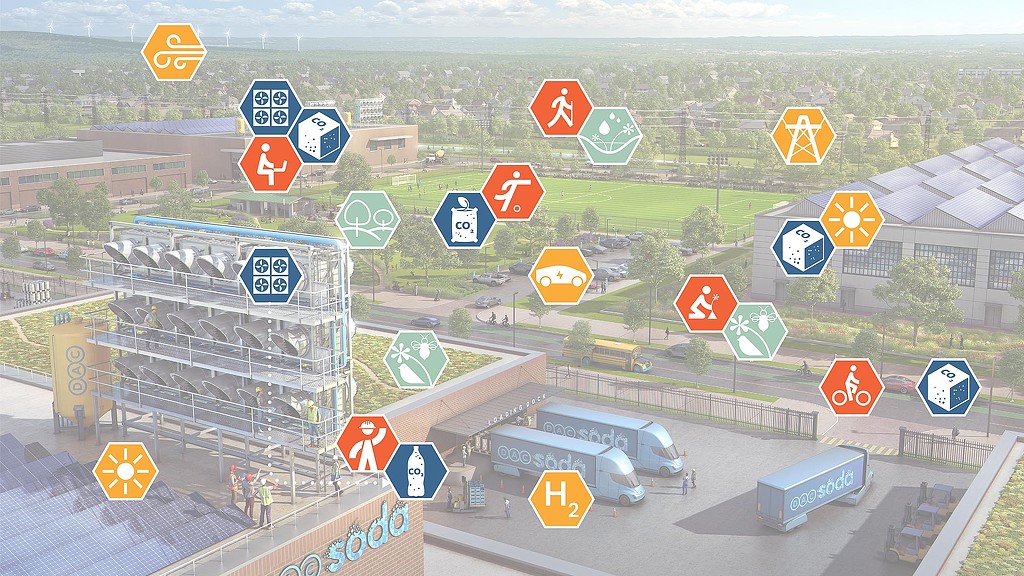Borealis: The Opportunity for Building Integrated Carbon Capture to Reverse the Carbon Footprint of Buildings
September 06, 2023 | By Naomi Sakamoto
We’ve all heard the statistic: buildings are responsible for 40% of global emissions. And as we continue to urbanise, with 70% of the global population expected to live in cities by 2050, our carbon emissions will balloon. But what if we could reverse the carbon footprints of our buildings, transforming them from a tap into a sponge? There are natural ways to remove carbon dioxide from the atmosphere, like forests and oceans. But we also have technological means of carbon removal, including direct-air carbon capture, or DAC.
Direct-air carbon capture is a chemical or mechanical process that isolates the carbon dioxide from ambient air. Unlike point-source carbon capture, DAC can be located anywhere, and the first installations of this technology have been in remote areas. Orca, the world’s largest DAC installation, which opened in Iceland in 2021, uses arrays of industrial fans to blow ambient air across a filter to collect the CO2, which is sequestered underground. But rather than constructing and powering enormous fans in remote locations, what if we could piggyback on existing building HVAC systems to transform every building into a carbon absorber?
Part 1: Inhale
Innovators are already developing carbon removal technologies that are integrated into building systems. We consulted with several of these experts and for the first stage of our research, we partnered with a Helsinki-based startup, Soletair Power, along with the global climate engineering firm Introba, to evaluate one of these emergent technologies in a hypothetical commercial building. Soletair Power has pioneered a sorbent-based DAC unit, the first commercial unit of which was installed last year.
Accounting for the efficacy of the carbon removal, as well as the embodied and operational carbon of the unit, we found that this technology can already save over 50,000 kilograms of carbon dioxide equivalent (kgCO2e) net over its 20-year lifespan, over three times that of a photovoltaic installation on the same building. And as the technology matures, it is on track to improve to 200,000 kgCO2e net carbon savings over its lifespan. To put this in context, if we were to apply technologies like these across Gensler’s 1.5 billion square foot annual portfolio, we could remove 14.5 million tonnes of CO2 from the atmosphere, or more than twice the total estimated carbon footprint of our 2030 portfolio. The complete analysis can be found on Introba’s website.
Part 2: Exhale
Once we’ve captured this carbon dioxide, what do we do with it? Could a building harvest carbon to enhance the user experience? Could a building connect us to our environmental impact and help us visualise our carbon footprint? Could we harvest buildings from thin air? For the second stage of our research, we plan to explore three separate use cases for the captured carbon:
- Solid applications based upon a mineral sequestration process. We are collaborating with a consortium of manufacturers to develop carbon-sequestering alternatives to common building and fitout materials such as workstations, carpets and flooring, gypsum wall board, and acoustic and insulating panels.
- Liquid applications that use captured CO2 as a replacement for refrigerants with high global warming potential or even as a long-duration battery, storing energy in CO2 to enable a decarbonised grid.
- Gaseous applications that use CO2 to enrich soils and greenhouses, filter water, and store and preserve food, enabling self-sustaining zero-mile kitchens and promoting food security.
The Opportunity
Building-integrated carbon removal presents an exciting future in which buildings could reverse their carbon footprint, transforming our urban environments from carbon offenders to environmental defenders. We envision the cities of the future as self-sustaining urban ecosystems, consciously designed to balance the CO2 we produce and the products, materials, and food we consume.
For media inquiries, email .

